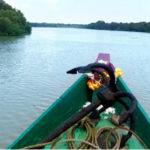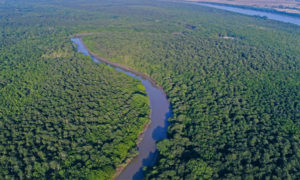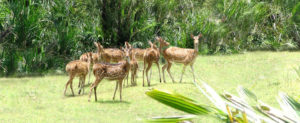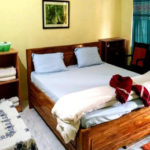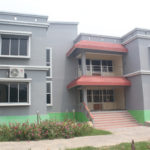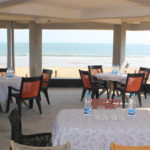If you are looking to spend some quiet time in the lap of nature, enjoying the beauty of lush greenery along with diversified flora and fauna—Bhitarkanika Mangrove Forest is the place that you are looking for. Situated in the Kendrapara District of Odhisa in the coast of Bay of Bengal, Bhitarkanika National Park is crisscrossed by rivers like Brahmani and Baitarani and hundreds of creeks and rivulets covering an area of 672 sq. kms. “Bhitara” in Odhiya means Interior and “Kanika” means exquisite beauty. Thus, Bhitarkanika Wildlife Sanctuary and National Park is known as the “Mini-Amazon” of India. BOOKING DETAILS OF BHITARKANIKA
Places to see in Bhitarkanika National Park: Bhitarkanika Mangroves were Zamindari forests until 1952 when the Government abolished the Zamindari System and incorporated it under the State Forest Department. In 1975, Bhitarkanika was established as a Wildlife Sanctuary. Bhitarkanika is the second largest Mangrove ecosystem of our country after Sundarbans and here you would discover untouched beaches like Habalikathi and breeding sites of Olive Ridley Turtles, Crocodile Breeding Centers and endless stretches of mangrove forests and hundreds of creeks. There are two main entry points to the Bhitarkanika National Park – Khola and Gupti villages. Entry permits are available at both checkpoints. Boats for transfers within the sanctuary are also available from both entry points.
Nearby attractions of Bhitarkanika National Park: Apart from the mangroves and wildlife Bhitarkanika is also home to few ruins and exquisite beaches like:
Batighar – It is the first lighthouse built in eastern coast and is surrounded with pleasant natural beauty. From Jumboo, an hour and 45 mins boat ride leads to Batighara. Visitors can see mangrove forests on both sides of river while moving on the boat.
Gahirmatha – The Gahirmatha Marine Sanctuary is famous as it is mass nesting ground of Olive Ridley sea turtle. Every year millions of this endangered species lay over 84 million eggs on the Gahirmatha Beach which is an awe inspiring site and attracts tourists from across the world. The sanctuary stretches from Batighar to Maipura river mouth. As of now, the Gahirmatha Marine Sanctuary stays closed to tourists during the Olive Ridley Breeding season.
Hukitola Island – The Hukitola Island is an ancient British Port and it is also known for being the breeding place of horse shoe crabs. The ancient Hukitola building is a glaring example of British architectural skill and is a symbol of its splendid past. The Island falls in the way from Jumboo to Batighar.
Kalibhanjadiha island – Situated in the river Dhamra, Kalibhanjadiha island can be reached from Khola. The island is covered in mangrove forests and you can often spot big saltwater crocs basking in the sun. Wild pigs and spotted deer can also be spotted roaming around. You need to hire a boat from Khola to visit this island.
Photos of Bhitarkanika
Things to do in Bhitarkanika National Park: Bhitarkanika is a perfect holiday destination for nature-lovers, adventure seekers and tourists in general. You can take boat-rides through the wild life sanctuary, see the places nearby or simply spend a quiet time relaxing in the lap of nature. You can catch a glimpse of variety of animals such as big salt water crocodiles, turtles, leopards, jackals, hyenas, porcupines, otters and fishing cats. It’s also a paradise for bird-watchers as colorful birds including winter migrants from central-Asia and Europe is very common here. Refresh your eyes with the greenery, rejuvenate your ears with the chirping of more than 170 species of resident and migratory birds while you enjoy excellent quality food and accommodation.
Best time to visit in Bhitarkanika National Park: You can visit Bhitarkanika any time of the year. If you are interested in Bird watching, winter is the best season although the Herons migrate in early June. The Oliver Ridley Turtles arrive between October and January to lay eggs and leave in May. The first nesting period of Olive Ridleys are around January and February and the second mass nesting happens sometime between March and April.
How to reach Bhitarkanika National Park: Khola and Gupti are the two main entry points for Bhitarkanika National Park. Visitors should take entry permit from the Forest Check Gate at Khola or Gupti. Forest Department and Private Boats are available at both the places. The nearest rail head is Bhadrak. The distance from Bhadrak to Gupti is around 82 kms. The nearest airport is located at Bhubaneshwar, which is 140 kms away from Gupti. Another major connectivity to Gupti is Cuttack, which is 125 kms away.
Lodging and Dining facilities at Bhitarkanika National Park: Lodging is available in Gupti, Dangamal and Habalikathi Island, like:
Dangamal Nature Camp: Visitors can make night stays in luxurious rooms of Dangamal Nature Camp. Here, we have 05 Double Bedded AC suites, 01 Triple Bed Non AC suite, 02 Four bedded suites, a dining hall and a kitchen.
Gupti Nature Camp: Situated inside the forests of Bhitarkanika and on the banks of river Patasala, Gupti Nature Camp has 6 luxury accommodations for night stay. It is the Entry Point to Bhitarkanika Sanctuary.
Habalikhati Nature Camp: On the glittering white sandy beach, Habalikhati Nature Camp, a beach resort, offers you 09 comfortable rooms facing the sea with all modern facilities. Here, we have 03 Four bedded Non AC suites, 02 Double bed AC suites, 04 Double Bed Tents and a Dining Hall. Habalikhati is one of the pristine and unexplored beaches of India. If you are lucky, you can Dolphins frolicking in the sea in the distance. Tourists have to hire boats from Gupti and take a 2:30 hrs boat ride along creeks to reach Habalikhati Nature Camp.
All Nature Camps have their own catering and serve food which is included in the package.
BOOKING DETAILS OF BHIARKANIKA

